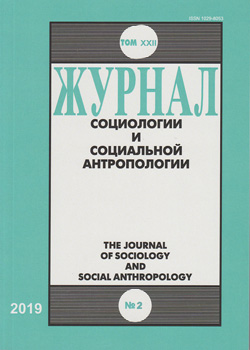The Literary Intertext of Pre-Revolutionary Russian Sociology
Keywords:
Russian pre-revolutionary sociologists; fiction; critical realism in literature; literary works of Russian sociologists.
Abstract
The article analyzes the influence of fiction on the development of Russian sociology of the mid-nineteenth — early twentieth century. The literary intertext provides an opportunity to complement and expand the vision of the process of formation and development of the sociology of this period. This connection existed in various forms. Its elements such as a reference to the names and texts of writers to illustrate their sociological concepts are highlighted; literary criticism, which was engaged in the Анализируется влияние художественной литературы на развитие отечественной социологии середины ХIХ — начала ХХ в. Связь с литературой дает возможность дополнить и расширить ви́дение процесса становления и развития социологии этого периода. Выделены такие элементы этой связи, как ссылка на имена и тексты литераторов для иллюстрации социологических концепций, литературная критика, которая занималась оценкой литературных произведений с точки зрения проблем общественной жизни, статьи о русских писателях, участие социологов в литературных сообществах и организациях, их деловые и дружеские отношения с писателями и поэтами. В центре внимания — использование социологами литературы в качестве объективных фактов эмпирической реальности, фактов времени и эпохи на основании онтологически родственного социологии метода реализма (критического реализма). Критический реализм с признанием О.Бальзака его основателем стал доминирующим направлением в российской литературе ХIХ в. Основанием для этого послужило то, что, в отличие от романтизма, при всем стилистическом разнообразии критический реализм ставил своей целью правдивое изображение действительности с акцентом на несправедливость, безнравственность общества и попыткой воздействовать на него через выбор характеров персонажей и описание окружающей среды. Это направление стало отражением процессов и явлений, происходящих в реальной общественной жизни, и предметом изучения в том числе социологии. Образная форма отражения действительности в литературе для социологов означала способ освоения явлений жизненного мира, наблюдаемых фактов действительности. Жизненная достоверность критического реализма стала основанием и для литературного творчества самих отечественных социологов, которые писали романы, повести, рассказы, стихи, эпиграммы.evaluation of literary works in terms of problems of public life; articles about Russian writers; participation of sociologists in literary communities and organizations; their business and friendships with writers and poets. The focus is on the use of literature by sociologists as objective facts of empirical reality, “facts” of time and epoch based on the ontologically related method of realism (critical realism) in literature. Critical realism with the recognition of O. Balzac as his “founder” became the dominant trend in Russian literature of the nineteenth century. The reason for this was that, unlike romanticism, with all its stylistic diversity, critical realism aimed at truthful portrayal of reality with an emphasis on injustice, immorality of society and an attempt to influence it through the choice of characters and a description of their environment. This direction was a reflection of the processes and phenomena occurring in public life, which is the subject of study in sociology. The figurative form of the reflection of reality in the literature for sociologists meant a way to master the phenomena of the life world, the observed facts of reality. The vital authenticity of critical realism became the basis for the literary works of Russian sociologists themselves, who wrote novels, stories, poems, epigrams.
Published
2019-09-20
How to Cite
Vera, V. (2019). The Literary Intertext of Pre-Revolutionary Russian Sociology. ZHURNAL SOTSIOLOGII I SOTSIALNOY ANTROPOLOGII (The Journal of Sociology and Social Anthropology), 22(2), 34-54. Retrieved from http://jourssa.ru/jourssa/article/view/289
Section
History of Sociology

